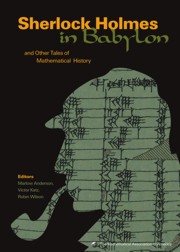Book contents
- Frontmatter
- Introduction
- Contents
- Ancient Mathematics
- Medieval and Renaissance Mathematics
- Foreword
- The Discovery of the Series Formula for π by Leibniz, Gregory and Nilakantha
- Ideas of Calculus in Islam and India
- Was Calculus Invented in India?
- An Early Iterative Method for the Determination of sin 1°
- Leonardo of Pisa and his Liber Quadratorum
- The Algorists vs. the Abacists: An Ancient Controversy on the Use of Calculators
- Sidelights on the Cardan-Tartaglia Controversy
- Reading Bombelli's χ-purgated Algebra
- The First Work on Mathematics Printed in the New World
- Afterword
- The Seventeenth Century
- The Eighteenth Century
- Index
- About the Editors
Reading Bombelli's χ-purgated Algebra
from Medieval and Renaissance Mathematics
- Frontmatter
- Introduction
- Contents
- Ancient Mathematics
- Medieval and Renaissance Mathematics
- Foreword
- The Discovery of the Series Formula for π by Leibniz, Gregory and Nilakantha
- Ideas of Calculus in Islam and India
- Was Calculus Invented in India?
- An Early Iterative Method for the Determination of sin 1°
- Leonardo of Pisa and his Liber Quadratorum
- The Algorists vs. the Abacists: An Ancient Controversy on the Use of Calculators
- Sidelights on the Cardan-Tartaglia Controversy
- Reading Bombelli's χ-purgated Algebra
- The First Work on Mathematics Printed in the New World
- Afterword
- The Seventeenth Century
- The Eighteenth Century
- Index
- About the Editors
Summary
Reading mathematics is hard work and reading a four hundred year old mathematics text is four hundred times harder. The language, notation and also the spirit are different from ours. If the reader is not already convinced from past experience, the following extract should prove the point.
Let us first assume that if we wish to find the approximate root of 13 that this will be 3 with 4 left over. This remainder should be divided by 6 (double the 3 given above) which gives 2 3 . This is the first fraction which is to be added to the 3, making 3 23 which is the approximate root of 13. Since the square of this number is 13 4 9, it is 4 9 too large, and if one wishes a closer approximation, the 6 which is the double of the 3 should be added to the fraction 2 3, giving 6 2 3, and this number should be divided into the 4 which is the difference between 13 and 9, …
If you understood—don't read on. If you didn't, then in this article we illustrate in some detail how a little perseverance can turn “obscurity” into a rewarding experience for students.
Bombelli's method
The text quoted above was written by Rafael Bombelli, a 16th century Italian mathematician. He wrote animportant textbook which appeared in two editions, L'algebra parte maggiore dell'arithmetica(1572) andL'algebra (1579).
- Type
- Chapter
- Information
- Sherlock Holmes in BabylonAnd Other Tales of Mathematical History, pp. 164 - 168Publisher: Mathematical Association of AmericaPrint publication year: 2003



